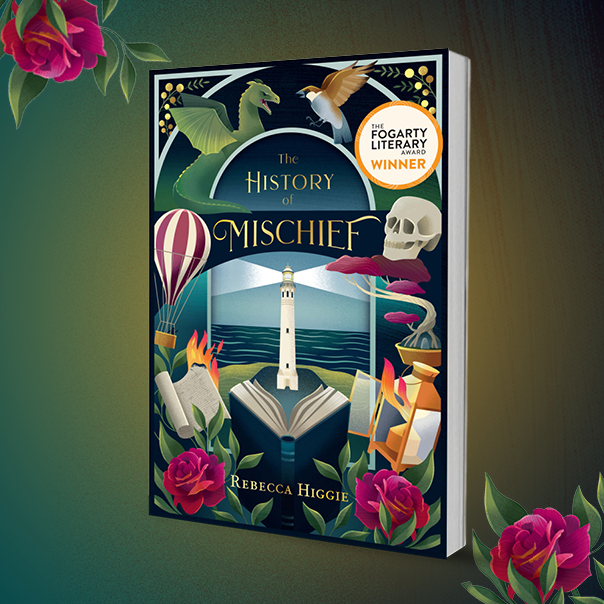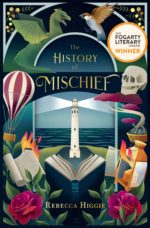It took academic turned library officer turned writer Rebecca Higgie 12 years to write her award-winning young adult novel The History of Mischief: a book for book lovers of all ages that won the inaugural Fogarty Literary Award for Western Australian writers aged 18 to 35

In this interview Rebecca talks about the histories behind the history and how these might be used to stimulate classroom discussions, research and writing activities.
How would you describe your novel and which (school) age groups do you think it is most suitable for?
Nine-year-old Jessie and her 20-year-old sister, Kay, have recently lost their parents in a car accident. They move to their grandmother’s abandoned house in Guildford, WA, and there, under the floorboards, they find a mysterious book called The History of Mischief. The book spans over two thousand years, chronicling a mysterious magical power called mischief. It follows ‘mischiefs’ from Ancient Greece, Egypt, China, Poland, France, Ethiopia, Britain and Australia.
The mystery of the book, and where it came from, lingers with Jessie as she tries to navigate life without her parents. Inspired by the book, she starts to conduct her own mischief, surprising her new school friend and an eccentric elderly neighbour who vacuums her driveway at night. It’s a novel about grief and the many stories we tell to protect ourselves and the ones we love.
It is a magical literary historical fiction suitable for teens and adults alike. I think Year 8 students and beyond would enjoy it. It tackles some meaty topics, like colonial violence, the Stolen Generations and forced adoption, so it could also complement complex political topics that students in upper secondary may be exploring.
The novel features many historical eras and settings. What kind of research did you do?
I searched for every resource I could find: books, academic articles, souvenir guides, fictional accounts, radio programs, documentaries, government reports, poetry, plays, memoirs, newspaper articles and quality online sources. I used my local library extensively to order books via inter-library loan, just like Jessie. In fact, all of the books and research materials that Jessie references in The History of Mischief are real! Students can easily find these books, like Frostiana, which was printed on the frozen River Thames in 1814!
Where possible, I also visited the places where the histories were set. For instance, I visited Augusta in Western Australia many times, and I went to local libraries and historical societies to do research. I’ve also visited Ethiopia and the Wieliczka Salt Mine in Poland, and I’ve lived in London, all locations that feature in the book.
Are there historical elements in the novel that might be suitable for classroom activities? How would you use those elements in the classroom?
Students can research all the historical events, people and mythology from the histories. One of the histories also explores the issue of repatriation, particularly around the issue of whether Britain should return the remains of Prince Alemayehu to Ethiopia. Repatriation would make an excellent topic for classroom debate.
Students could also hone their research skills by trying to find the references in the novel. Jessie rarely names the books and authors she finds in her research, but she gives clues. For instance, students could try and track down the ‘British-Ethiopian poet’ and ‘his poem about the Battle of Adwa’ on pages 230–231. They would discover the works of Lemn Sissay.
Writing students could be inspired to write their own histories. Pick a time period, a place or a historical figure, and insert mischief! Art students could also explore the world of origami, as Jessie conducts mischief through making paper cranes and leaving them in places for people. We’ve made an activity sheet and a video tutorial that students can access here.
You won the Fogarty Literary Award and you’d really like to get into schools to encourage young people to set their sights on writing their own books. What can a school expect if they book you for an author talk or workshop?
I have a unique background in schools, libraries and universities, so I can talk a lot about research and writing. Students often think of research as reading something boring that goes into an assignment. I believe research is about jumping into the rich centre of a topic, from tracking down menus that show zoo animals were eaten during the 1870 Paris siege to visiting lighthouses at night to see how the light works. Schools can expect me to bring my zeal for research into the classroom. My writing process is very ordered and practical, but I insert whimsy and play into how I approach the things I am writing about and researching.
Schools can also expect me to champion students who think they are ‘bad writers’. I believed I was a bad writer, and that is the main reason I took over 12 years to write The History of Mischief. I believe the best writing comes when we ‘break the rules’ and feel free to write the stories we need to tell, not what we believe others want to hear. I love to encourage students to write from the heart.
You are also the Fremantle Press Podcast host. What have you learned from interviewing your fellow children’s book authors and illustrators?
There is so much work that goes into a children’s book! From graphic novels to gritty YA, children’s book authors and illustrators go to extraordinary lengths to produce their books. They are very mindful of producing something authentic and engaging for their readers. I’ve found that the story behind their books – how they research, write, create – is often even more exciting than the books themselves.
The History of Mischief is available in all good bookstores and online from 1 September 2020 and the book will be launched at South Perth Library on Thursday 8 October 2020. Free teaching notes, a teaching activity and a sample chapter are all available online and you can order class sets of bookmarks and teaching activities by emailing admin@fremantlepress.com.au.



